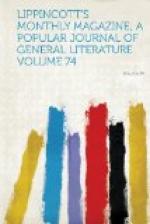As the coral, in its soft, milky chalk, gives a name to tropical seas, so also it is a question to my simplicity if the Yellow Sea, Black Sea and White Sea do not owe their color and name, in part at least, to microscopic infusoriae. One of these, the Yellow Sea, is very similar in many characteristics to our beautiful southern gulf, and there is connected with it an incident or two illustrative of submarine adventure which is the partial purpose of this desultory sketch.
About the time our American was investing in Pharaoh’s golden chariot-wheels an East Indiaman was trading its way from the English docks, eighteen weary weeks’ sail by seamen’s law, and more tedious by delays. They exchanged for bullion on the Gold Coast; for bullion and bad Cape brandy at Good Hope to sell to the Mohammedans, who are forbidden to drink it. At Bombay and Calcutta they exchanged bullion and brandy for opium to sell to the Chinese, who are forbidden to buy or use it. Whether the coolie trade was included in its iniquities or not, I cannot say. Very possibly that was the return cargo. From Ceylon they proceed to Siam, and thence to Hong-Kong, where they drop anchor in the offing, and by a special custom the cargo is sold and paid for in sycee silver before disfreighting, and the bullion is in the safe of the huge smuggler, although the opium has not yet been removed. The Chinese restrictive laws are very severe; but when we note that ninety thousand gallons of confiscated whisky were seized in godly Massachusetts in one year, we can infer the difficulties in the Maine law of the Celestials. The custom is for a hong, a smuggler in a Chinese junk, to draw up beside the English contrabandist and transfer the cargo in the outer harbor.




